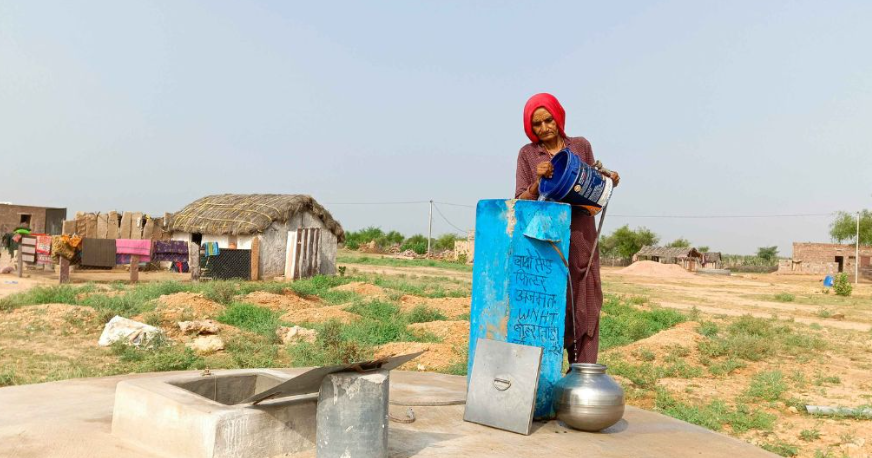Water Surges in Rajasthan’s Desert Town (GS Paper 1, Geography)

Context
- On December 28, 2023, a surprising incident occurred in Mohangarh, Rajasthan, when water surged unexpectedly during a tubewell drilling operation.
- This rare event sparked speculation that it might signify the return of the ancient Saraswati River, a river referenced in Hindu texts.
- However, experts quickly explained that the phenomenon was likely caused by the presence of an artesian well, a naturally pressurized water source found underground.
What Are Artesian Wells?
- An artesian well is a type of well where water rises to the surface naturally, without the need for mechanical pumping.
- This occurs when groundwater is confined under pressure in a geological layer, often sandstone.
- The pressure forces the water upward when a borehole or well penetrates the layer, allowing the water to flow freely.
- While this occurrence is rare, it is not unheard of in desert regions like Rajasthan, which has a variety of geological formations that can give rise to such wells.
Geological Significance of the Incident
- The unexpected surge of water in Mohangarh likely resulted from the drilling operation breaching a sandstone barrier that was keeping an aquifer sealed.
- This triggered the release of pressurized water.
- This kind of event highlights the unique geological factors in Rajasthan’s desert landscape, where underground aquifers exist beneath layers of rock and sand.
- Rajasthan, known for its arid conditions, is rich in underground water sources, which are often tapped for agricultural and domestic needs.
- The discovery of artesian wells adds an important dimension to the understanding of the region’s water resources.
Assessing the Situation: Safety Measures
- Following the water surge, safety assessments were promptly conducted by local authorities.
- Hydro-geologist Narayan Das Inakhiya confirmed that the water flow had ceased after the initial surge, and there was no ongoing risk to nearby residents.
- Furthermore, government teams conducted tests on the gases released during the surge, which were found to be non-hazardous.
- This helped reassure the local population that the event, while unusual, did not pose a significant threat to their safety or health.
Future Investigations into Underground Water Sources
- In response to the surprising water surge, the Union Minister for Science and Technology, Jitendra Singh, outlined plans for further investigation into the aquifers of Rajasthan.
- Scientists from CSIR (Council of Scientific and Industrial Research) will conduct comprehensive surveys to identify and map additional underground aquifers in the region.
- These surveys will employ advanced technology, including heliborne surveys, which can effectively detect hidden water sources beneath the ground.
- The goal is to improve the understanding of water availability in Rajasthan and enhance water resource management in the future.
The Saraswati River: Myth or Reality?
- The Saraswati River holds a central place in ancient Indian civilization, being frequently mentioned in the Rigveda and other ancient texts.
- It is considered a mythological river, playing an important role in the spiritual and cultural landscape of ancient India.
- Historically, it is believed that the Saraswati River dried up over 5000 years ago, possibly due to climatic changes, tectonic shifts, or other geological events.
- The idea that water surges in Rajasthan might be connected to the Saraswati has sparked significant interest, but experts stress that the recent event is more likely linked to the presence of underground artesian wells rather than the river’s resurgence.
Artesian Wells and Water Security in Rajasthan
- Artesian wells represent a valuable natural water source, particularly in arid regions like Rajasthan.
- These wells provide water that can flow naturally to the surface, potentially helping to alleviate water scarcity in desert areas.
- Rajasthan’s unique geological features, including its sandstone formations, make it a prime location for artesian wells, offering a potential solution to some of the region’s water scarcity issues.
- While these wells can serve as crucial sources of water, they also underscore the importance of sustainable water management practices in regions with limited natural resources.
The Role of Local Governance and Water Resource Management
- Local governance plays a key role in managing water resources responsibly.
- The Rajasthan government has emphasized the need for careful drilling operations to avoid disrupting fragile underground aquifers and to ensure sustainability in water management.
- Proper planning and regulation are crucial to prevent over-extraction of groundwater and to ensure that resources are used wisely.
- In addition, understanding the region’s aquifers and their characteristics is essential for formulating long-term water management strategies that can support local communities, agriculture, and the economy.
- Collaboration between scientists, local authorities, and government agencies is vital to ensure that Rajasthan's water resources are managed effectively.
Conclusion: A New Chapter in Rajasthan’s Water Resources
- The water surge in Mohangarh has highlighted the importance of artesian wells as a natural water source in Rajasthan’s desert regions.
- While the Saraswati River remains a subject of mythological fascination, the event has brought attention to the region’s hidden underground aquifers and the potential of natural water reserves to support communities in arid areas.
- Moving forward, scientific research, geological surveys, and sustainable water management practices will be critical in ensuring that Rajasthan can meet its future water needs, while also safeguarding its unique natural resources.


